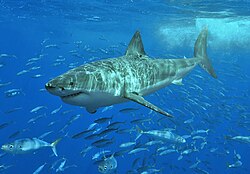
The following outline is provided as an overview of and topical guide to sharks:
Contents
- Fields that study sharks
- Description
- Biological classification
- Types of sharks
- Shark behavior
- Shark attacks
- Range and habitats of sharks
- Range
- Habitats
- Shark anatomy
- Protective equipment
- Shark fishing
- Shark conservation
- Notable sharks
- Notable researchers and people
- See also
- References
- External links
Sharks (division Selachii) are a type of fish with a full cartilaginous skeleton and a highly streamlined body. The earliest known sharks date from more than 440 million years ago, before the time of the dinosaurs. [1]







